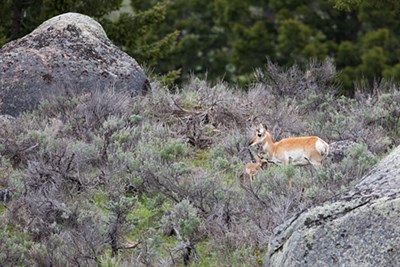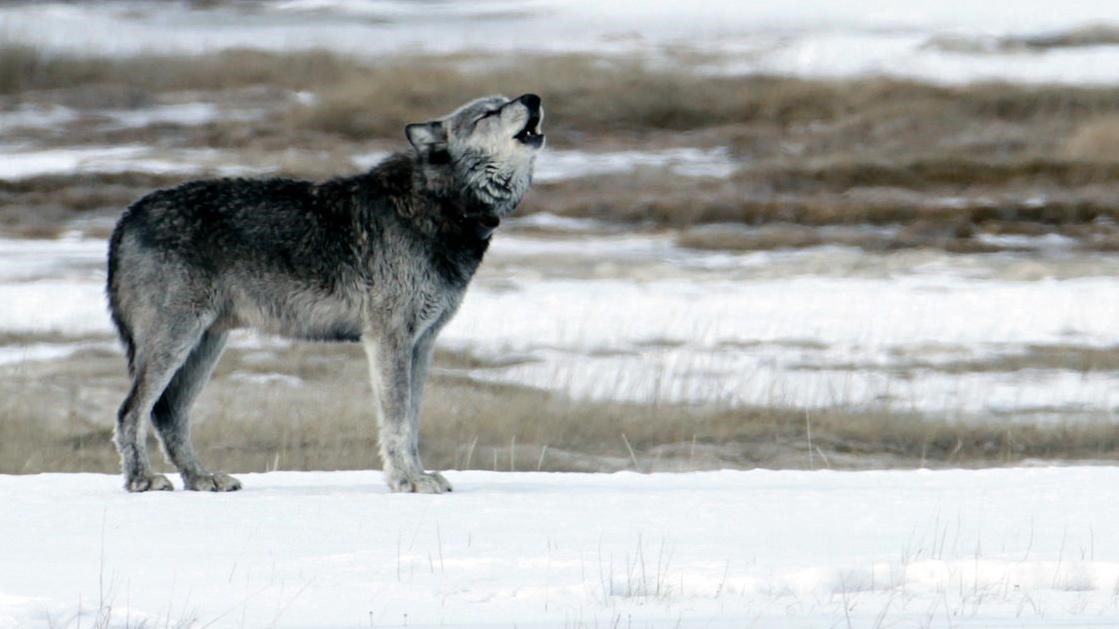
NPS / Neal Herbert The North American pronghorn (Antilocapra americana) is the surviving member of a group of animals that evolved in North America during the past 20 million years. It is not a true antelope, which is found in Africa and southeast Asia. The use of the term “antelope” seems to have originated when the first written description of the animal was made during the 1804–1806 Lewis and Clark Expedition. DescriptionThe pronghorn has true horns, made of modified, fused hair that grows over permanent bony cores, but they differ from those of other horned animals in two major ways: the sheaths are shed and grown every year and they are pronged. (A number of other horned mammals occasionally shed their horns, but not annually.) Adult males typically have 10–16 inch horns that are curved at the tips. About 70% of the females also have horns, but they average 1–2 inches long and are not pronged. The males usually shed the horny sheaths in November or December and begin growing the next year’s set in February or March. The horns reach maximum development in August or September. Females shed and regrow their horns at various times. Pronghorn are easy to distinguish from the park’s other ungulates. Their deer-like bodies are reddish-tan on the back and white underneath, with a large white rump patch. Their eyes are very large, which provides a large field of vision. Males also have a black cheek patch. BehaviorFemales that bred the previous fall commonly deliver a set of twins in May or June. The newborn fawns are a uniform grayish-brown and weigh 6–9 pounds. They can walk within 30 minutes of birth and are capable of outrunning a human in a couple of days. The young normally stay hidden in the vegetation while the mother grazes close by. After the fawns turn three weeks old they begin to follow the females as they forage. Several females and their youngsters join together in nursery herds along with yearling females. Pronghorn form groups most likely for increased protection against predators. When one individual detects danger, it flares its white rump patch, signaling the others to flee. The pronghorn is adapted well for outrunning its enemies—its oversized windpipe and heart allow large amounts of oxygen and blood to be carried to and from its unusually large lungs. Pronghorn can sustain sprints of 45–50 mph. Such speed, together with keen vision, make the adults difficult prey for any natural predator. Fawns, however, can be caught by coyotes, bobcats, wolves, bears, and golden eagles. The pronghorn breeding season begins mid-September and extends through early October. During the rut the older males “defend” groups of females (called a harem). They warn any intruding males with loud snorts and wheezing coughs. If this behavior does not scare off the opponent, a fight may erupt. The contenders slowly approach one another until their horns meet, then they twist and shove each other. Eventually, the weaker individual will retreat. Although the fights may be bloody, fatalities are rare. The most important winter foods are shrubs like sagebrush and rabbitbrush; they eat succulent forbs during spring and summer. They can eat lichens and plants like locoweed, lupine, and poisonvetch that are toxic to some ungulates. Their large liver (proportionately, almost twice the size of a domestic sheep’s liver) may be able to remove plant toxins from the blood stream. Grasses appear to be the least-used food item, but may be eaten during early spring when the young and tender shoots are especially nutritious. During winter, pronghorn form mixed-sex and-age herds. In spring, they split into smaller bands of females, bachelor groups of males between 1–5 years old, and solitary older males. The small nursery and bachelor herds may forage within home ranges of 1,000 to 3,000 acres while solitary males roam smaller territories (60 to 1,000 acres in size. Pronghorn, including three-fourths of the individuals in Yellowstone, migrate between different winter and summer ranges to more fully utilize forage within broad geographic areas. 
PopulationDuring the early part of the 1800s, pronghorns ranked second only to bison in numbers, with an estimated 35 million throughout the West. The herds were soon decimated by conversion of rangeland to cropland, professional hunters who sold the meat, and ranchers who believed that pronghorns were competing with livestock for forage. Today, due to transplant programs and careful management, pronghorns roam the sagebrush prairies in herds totaling nearly 500 thousand animals. The pronghorn’s population fluctuations on the northern range show the effects of management interventions as well as natural shifts in forage availability, competition with elk, and predation. Efforts to keep pronghorn in the park with fences and winter feeding reduced their abundance and use of migratory routes by the 1920s, and about 1,200 pronghorn were removed from 1947 to 1967 to address perceived sagebrush degradation. Complaints about crop depredation led to the removal of about 190 pronghorn on private land from 1985 to 2002. The reason for the sudden population decline in the early 1990s remains unclear, but fawn survival appears to have been low. Probably due to coyote predation and reduction of winter range north of the park through development by private land owners. The pronghorn winter range inside the park is former agricultural land infested with nonnative vegetation of low nutritional quality. Since the mid 2000’s, the pronghorn population has seen a steady rebound in population, and since 2012 the population has recovered to the highest population estimates since the early 1990’s. Removal of fences and better forage availability in areas adjacent to Yellowstone Park appears to have reduced predation factors on pronghorn on winter range, and are some of the contributing factors attributed to increases in pronghorn numbers. Outside Yellowstone National Park, a limited pronghorn hunt was re-established in response to population increases beginning in 2016. Since the early 2000’s, evidence of migration and dispersal into Paradise Valley and mixing with pronghorn herds outside the park has improved the long-term viability of the Yellowstone population. Research continues to search for answers concerning the Yellowstone pronghorn herd. This small population continues to be susceptible to extirpation from random catastrophic events such as a severe winter or disease outbreaks. ResourcesBarmore, W.J. Jr. 2003. Ecology of ungulates and their winter range in Northern Yellowstone National Park, Research and Synthesis 1962–1970. Yellowstone Center for Resources. Barnowe-Meyer, K.K. 2009. The behavioral ecology and population genetics of pronghorn in Yellowstone National Park. University of Idaho, Moscow, Idaho. Barnowe-Meyer, K.K., P.J. White, T.L. Davis, and J.A. Byers. 2009. Predator-specific mortality of pronghorn on Yellowstone’s northern range. Western North American Naturalist 69(2):186–194. Barnowe-Meyer, K.K., P.J. White, and J.A. Byers. 2011. Maternal investment by Yellowstone pronghorn following winter habitat deterioration. Western North American Naturalist 71:222–233. Barnowe-Meyer, K.K., P.J. White, T.L. Davis, D.W. Smith, R.L. Crabtree, and J.A. Byers. 2010. Influences of wolves and high-elevation dispersion on reproductive success of pronghorn (Antilocapra americana). Journal of Mammalogy 91:712–721. Byers, J.A. 2003. Built for speed: A year in the life of pronghorn. Harvard University Press. Keating, K. 2002. History of pronghorn population monitoring, research, and management in Yellowstone National Park. Report to the National Park Service by USGS Northern Rocky Mountain Science Center, Bozeman, MT. Sawyer, H., F. Lindzey, and D. McWhirter. 2005. Mule deer and pronghorn migration in western Wyoming. Wildlife Society Bulletin 33(4):1266–1273. Scott, M.D. 2004. History of pronghorns translocated from Yellowstone National Park. In 21st Biennial Pronghorn Workshop Proceedings, 114–133. Taylor, M. 2006. Ancient corridors: The trapper’s point story of the prehistoric path of the pronghorn. In A. W. Biel, ed., Greater Yellowstone public lands: A century of discovery, hard lessons, and bright prospects: Proceedings of the 8th Biennial Scientific Conference on the Greater Yellowstone Ecosystem, 178–180. Yellowstone National Park, WY: Yellowstone Center for Resources. White, P.J. and J. Treanor. 2002. Yellowstone Pronghorn Conservation Assessment Workshop. Yellowstone National Park, Yellowstone Center for Resources. White, P.J., J.E. Bruggeman, and R. A. Garrott. 2007. Irruptive population dynamics in Yellowstone pronghorn. Ecological Applications 17(6):1598–1606. White, P.J., et al. 2007. Partial migration and philopatry of Yellowstone pronghorn. Biological Conservation 135:518–526. White, P.J., C.N. Gower, T.L. Davis, J.W. Sheldon, and J.R. White. 2012. Group dynamics of Yellowstone pronghorn. Journal of Mammalogy 93:1129–1138. 
Mammals
Home to the largest concentration of mammals in the lower 48 states. |
Last updated: April 17, 2025
